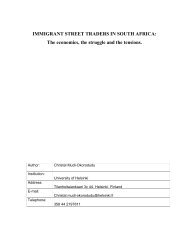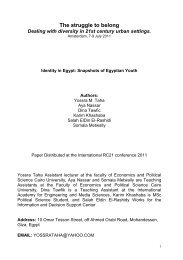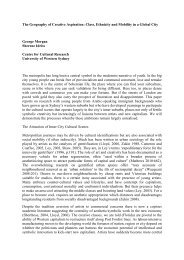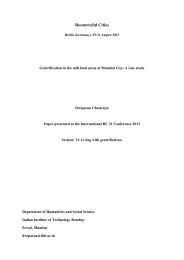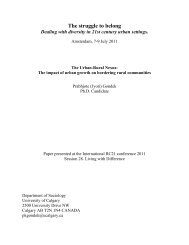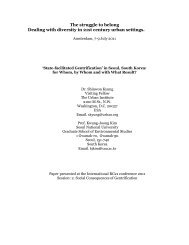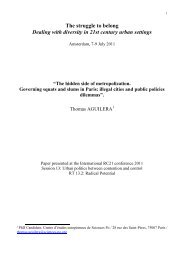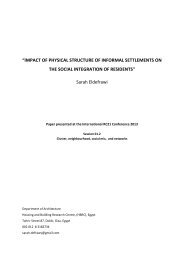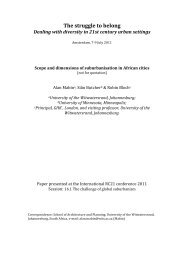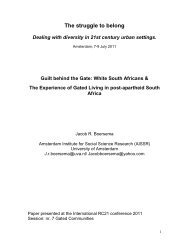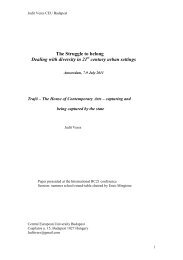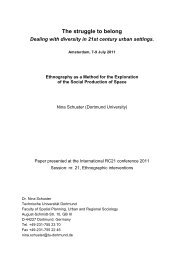Fragmentation as a threat to social cohesion - RC21 ORG ...
Fragmentation as a threat to social cohesion - RC21 ORG ...
Fragmentation as a threat to social cohesion - RC21 ORG ...
You also want an ePaper? Increase the reach of your titles
YUMPU automatically turns print PDFs into web optimized ePapers that Google loves.
enforced by their importance <strong>to</strong> the spatial organization of crime. In this sense,<br />
favel<strong>as</strong> are highly perceived and represented in debates on urban security and the<br />
res<strong>to</strong>ration of urban order. Within this logic, favel<strong>as</strong> have <strong>to</strong> be integrated and<br />
transformed in<strong>to</strong> “legal” places. On the other hand, their interwovenness is often<br />
neglected, because the maintenance of a cheap and legally subordinate work force is<br />
crucial <strong>to</strong> the maintenance of the economic order of the capitalist city. This is why the<br />
connections and disconnections of the favela interrelate and depend on each other –<br />
the favela being alternately constructed <strong>as</strong> both, interwoven and disconnected<br />
fragment, <strong>as</strong> well <strong>as</strong> a completely unconnected segment.<br />
5. Urban fragmentation <strong>as</strong> a <strong>threat</strong> <strong>to</strong> <strong>social</strong> <strong>cohesion</strong>?<br />
Speaking of fragmentation includes the danger that we are indirectly talking of<br />
fragments of order and disorder. Thus, we are following the binary code of being<br />
included or excluded from the whole spectrum of the urban. In this sense,<br />
fragmentation is a normative concept and focuses negatively on disconnections,<br />
rather than connections. As an analytical concept, fragmentation bears the potential<br />
of understanding newly emerging patterns of simultaneous disconnections and<br />
interwovenness. Relating <strong>to</strong> <strong>social</strong> <strong>cohesion</strong>, fragmentation <strong>as</strong> a state of socio-spatial<br />
patterns does not question <strong>cohesion</strong> – but certainly the process of fragmentation<br />
questions and deconstructs a socio-spatial order that h<strong>as</strong> been shaping cities for so<br />
long: functional segmentation and segregation. For further research, fragmentation<br />
should be made fruitful <strong>as</strong> a concept that helps <strong>to</strong> understand how <strong>social</strong> <strong>cohesion</strong> in<br />
<strong>to</strong>day's cities is being produced and reproduced, and which forms of <strong>as</strong>sociation and<br />
dissociation coexist.<br />
Still, we should bear in mind that fragmentary structures may neglect or hide<br />
hierarchical or vertical structures that impede certain connections – and lead <strong>to</strong><br />
segmentary cleavages. As for the two extremes, favel<strong>as</strong> and gated communities<br />
show certain <strong>as</strong>pects of strong segmentation even though depending on each other.<br />
To use fragmentation <strong>as</strong> a negative normative concept of dissolution and disorder<br />
means <strong>to</strong> give way <strong>to</strong> an elite bi<strong>as</strong>, neglecting the interwovenness of the so-called<br />
'formal' units with the 'informal' units and legitimizing fortification <strong>as</strong> a response <strong>to</strong> the<br />
'dangerous fragments'. As the analysis of Brazilian favel<strong>as</strong> h<strong>as</strong> shown,<br />
interwovenness is mostly given in economic and work-b<strong>as</strong>ed <strong>as</strong>pects, which includes<br />
the favela-located drug-economy. Distinction certainly is most accentuated in terms<br />
of socio-cultural <strong>as</strong>pects. We may not confuse them with an “elite culture” on the one<br />
side and a “culture of poverty” on the other. In this sense, fragmentation does allow<br />
for more careful distinctions, and certainly gives way <strong>to</strong> understanding more<br />
thoroughly how, and by what means, <strong>social</strong> spaces and their cultural <strong>as</strong>pects are<br />
being produced externally and internally by the <strong>social</strong> groups that form urban<br />
societies. They still produce one urban reality, however fragmented – simultaneously<br />
disconnected and interwoven – it may be.<br />
Bibliography<br />
Caldeira, T. P. do Rio (1992): City of Walls: Crime, Segregation, and Citizenship in Sao<br />
Paulo. Berkeley: University of California Press<br />
C<strong>as</strong>tells, M. (2001 [1996]), D<strong>as</strong> Informationszeitalter 1: Der Aufstieg der<br />
Netzwerkgesellschaft. Opladen: Leske+Budrich<br />
12 Deffner, Hoerning: <strong>Fragmentation</strong> <strong>as</strong> a Threat <strong>to</strong> Social Cohesion?



